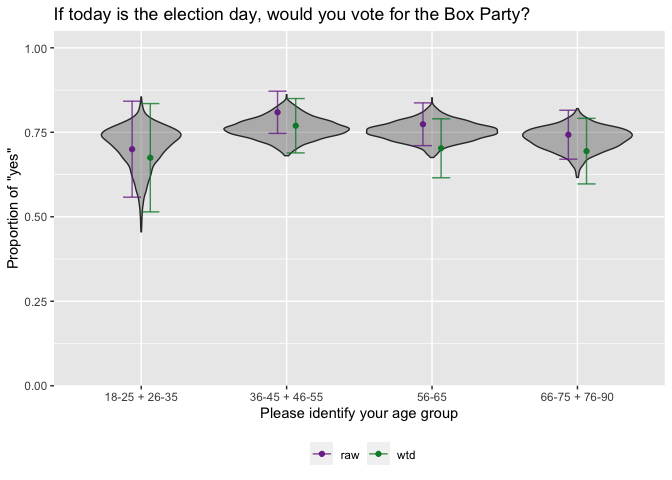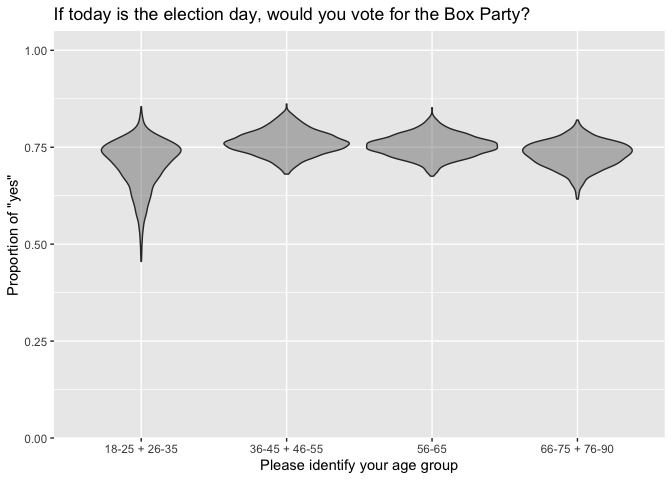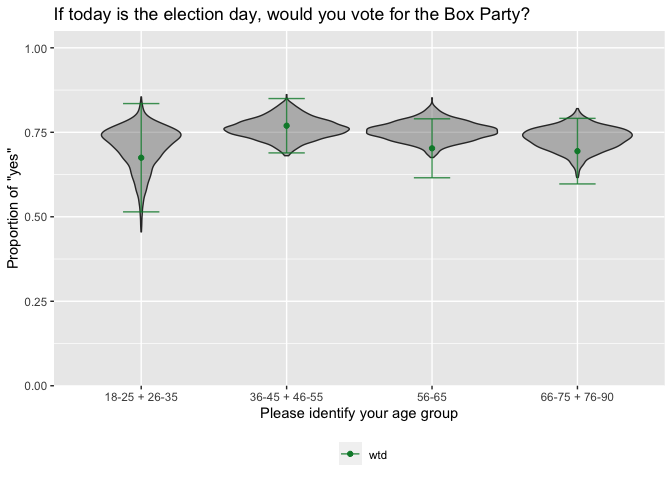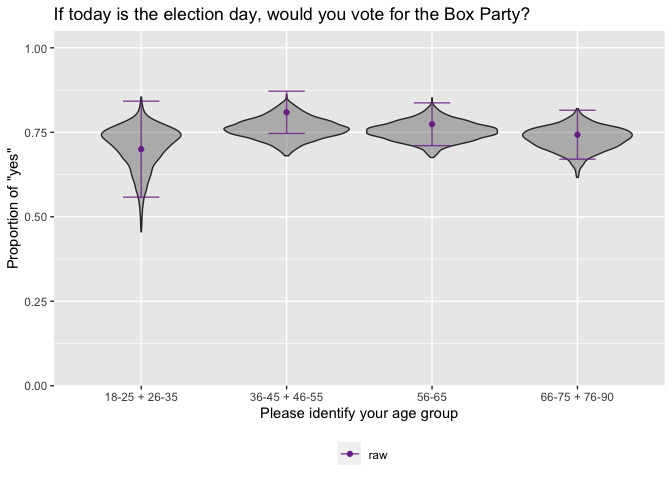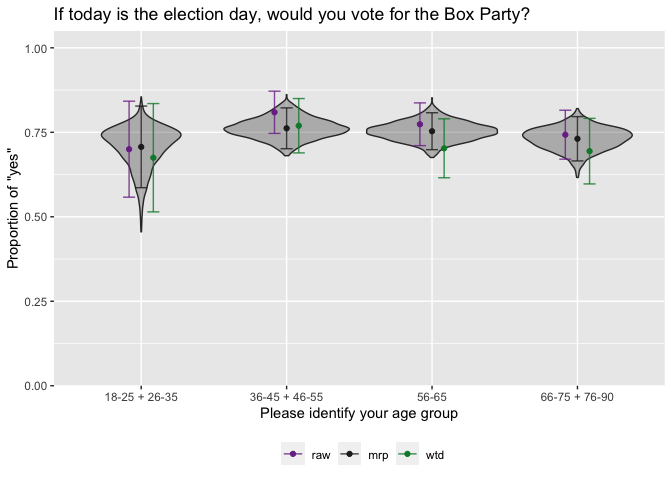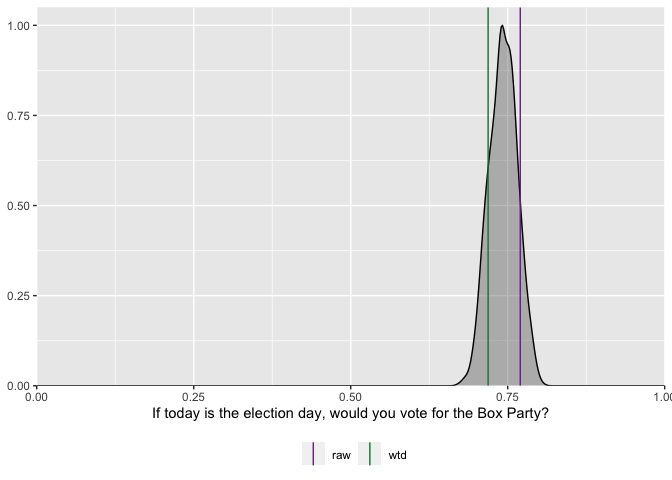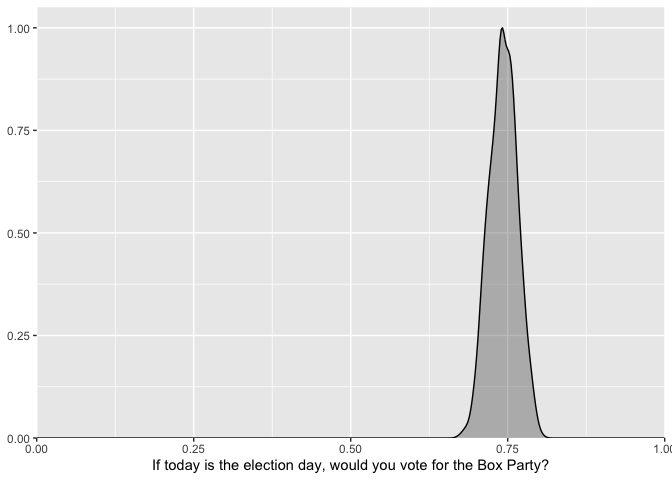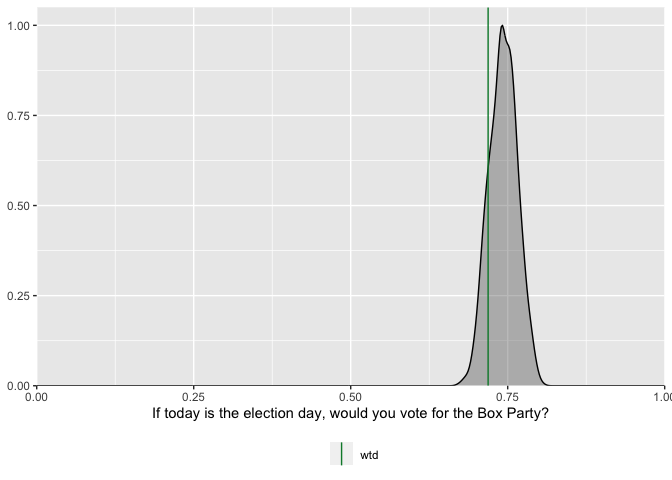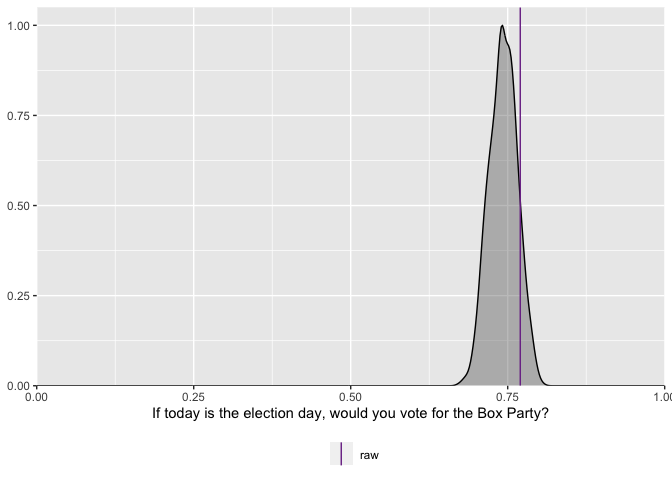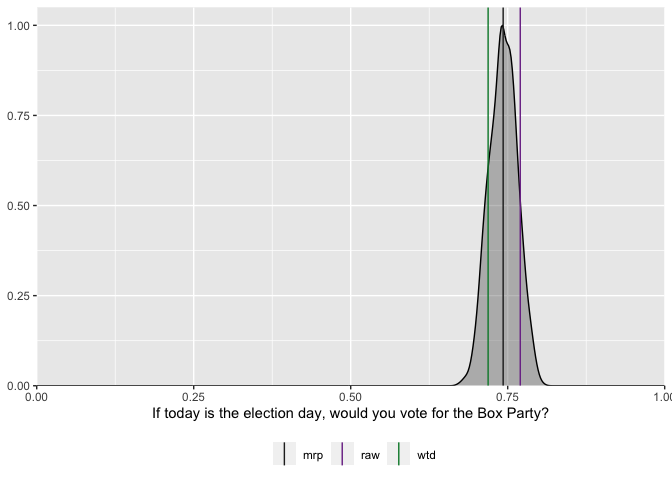NOTE: This package is still a work in progress and is yet not released or officially supported
For students and researchers who are comfortable with at least glm()
and want to conduct multilevel regression with post-stratification
(MRP), the mrpkit R package provides a reproducible, opinionated, and
highly structured workflow. Unlike writing all the code yourself, using
mrpkit proactively addresses many common issues, and makes it possible
for people who are new to MRP to quickly conduct their first analysis.
The package first assists in setting up the survey data and
relationships between different variables in the sample and the
population. From there, a substantial amount of data cleaning is
automated, saving time and reducing the risk of coding errors. mrpkit
has native support for multilevel binomial and Bernoulli models fit with
lme4 and Stan (via brms and rstanarm) and also allows for the use of
custom modeling functions. After model fitting, mrpkit handles the
post-stratification step, producing population and sub-population
estimates. Summary statistics and simple visualizations of the resulting
MRP estimates are provided.
You can install the development version of mrpkit from GitHub:
# install.packages("remotes")
remotes::install_github("lauken13/mrpkit")mrpkit is licensed under an MIT license. See the LICENSE.md file.
library(mrpkit)
# Some fake survey data for demonstration
head(shape_survey)
#> age gender vote_for highest_educ state y wt
#> 1 56-65 male BP some college State D no 79.90290
#> 2 46-55 male Circle Party 4-year college State B yes 89.12213
#> 3 36-45 male Circle Party associates State D no 92.90569
#> 4 18-25 male Box Party high school State B yes 80.78384
#> 5 56-65 female BP high school State A yes 89.85756
#> 6 56-65 female Circle Party 4-year college State B yes 117.04200
# Create SurveyData object for the sample
box_prefs <- SurveyData$new(
data = shape_survey,
questions = list(
age = "Please identify your age group",
gender = "Please select your gender",
vote_for = "Which party did you vote for in the 2018 election?",
y = "If today is the election day, would you vote for the Box Party?"
),
responses = list(
age = levels(shape_survey$age),
gender = levels(shape_survey$gender),
# Here we use a dataframe for the responses because the levels in the data are abridged versions of the actual responses
# This can be useful when surveys have brief/non descriptive responses.
vote_for = data.frame(data = levels(shape_survey$vote_for),
asked = c("Box Party Faction A", "Box Party Faction B", "Circle Party Coalition", "Circle Party")),
y = c("no","yes")
),
weights = "wt",
design = list(ids =~1)
)
box_prefs$print()
#> Survey with 500 observations, 4 questions
#> Independent Sampling design (with replacement)
#>
#> Column label: age
#> Question: Please identify your age group
#> Allowed answers: 18-25, 26-35, 36-45, 46-55, 56-65, 66-75, 76-90
#>
#> Column label: gender
#> Question: Please select your gender
#> Allowed answers: male, female, nonbinary
#>
#> Column label: vote_for
#> Question: Which party did you vote for in the 2018 election?
#> Allowed answers: Box Party ( Box Party Faction A ), BP ( Box Party Faction B ), Circle Party ( Circle Party Coalition ), CP ( Circle Party )
#>
#> Column label: y
#> Question: If today is the election day, would you vote for the Box Party?
#> Allowed answers: no, yes
box_prefs$n_questions()
#> [1] 4
# Some fake population data for demonstration
head(approx_voters_popn)
#> age_group gender vote_pref wt education state
#> 1 66+ m BP 6.007461 4-years college A
#> 2 56-65 f CP 8.465851 high school A
#> 3 56-65 m CP 4.098878 4-years college C
#> 4 66+ m BP 3.883250 4-years college C
#> 5 66+ f CP 16.179562 some college B
#> 6 18-35 m BP 3.851837 high school D
# Create SurveyData object for the population
popn_obj <- SurveyData$new(
data = approx_voters_popn,
questions = list(
age_group = "Which age group are you?",
gender = "Gender?",
vote_pref = "Which party do you prefer to vote for?"
),
# order doesn't matter (gender before age here) because
# the list has the names of the variables
responses = list(
gender = levels(approx_voters_popn$gender),
age_group = levels(approx_voters_popn$age_group),
vote_pref = levels(approx_voters_popn$vote_pref)
),
weights = "wt"
)
popn_obj$print()
#> Survey with 5000 observations, 3 questions
#> Independent Sampling design (with replacement)
#>
#> Column label: age_group
#> Question: Which age group are you?
#> Allowed answers: 18-35, 36-55, 56-65, 66+
#>
#> Column label: gender
#> Question: Gender?
#> Allowed answers: m, f, nb
#>
#> Column label: vote_pref
#> Question: Which party do you prefer to vote for?
#> Allowed answers: BP, CP
# Create the QuestionMap objects mapping each question between the
# survey and population dataset
q_age <- QuestionMap$new(
name = "age",
col_names = c("age","age_group"),
values_map = list(
"18-25" = "18-35", "26-35" = "18-35","36-45" = "36-55",
"46-55" = "36-55", "56-65" = "56-65", "66-75" = "66+", "76-90" = "66+"
)
)
print(q_age)
#> --------------
#> age
#> age = age_group
#> --------------
#> 18-25 = 18-35
#> 26-35 = 18-35
#> 36-45 = 36-55
#> 46-55 = 36-55
#> 56-65 = 56-65
#> 66-75 = 66+
#> 76-90 = 66+
q_party_pref <- QuestionMap$new(
name = "party_pref",
col_names = c("vote_for","vote_pref"),
values_map = list("Box Party" = "BP", "BP" = "BP","Circle Party" = "CP", "CP" = "CP")
)
q_gender <- QuestionMap$new(
name = "gender",
col_names = c("gender", "gender"),
values_map = list("male" = "m","female" = "f", "nonbinary" = "nb")
)
# Create SurveyMap object adding all questions at once
ex_map <- SurveyMap$new(
sample = box_prefs,
population = popn_obj,
q_age,
q_party_pref,
q_gender
)
#> Warning: Variable(s) 'education', 'state' are available in the population but
#> won't be used in the model
print(ex_map) # or ex_map$print()
#> ==============
#> age = age_group
#> --------------
#> 18-25 = 18-35
#> 26-35 = 18-35
#> 36-45 = 36-55
#> 46-55 = 36-55
#> 56-65 = 56-65
#> 66-75 = 66+
#> 76-90 = 66+
#> ==============
#> vote_for = vote_pref
#> --------------
#> Box Party = BP
#> BP = BP
#> Circle Party = CP
#> CP = CP
#> ==============
#> gender = gender
#> --------------
#> male = m
#> female = f
#> nonbinary = nb
# Or can add questions incrementally
ex_map <- SurveyMap$new(sample = box_prefs, population = popn_obj)
print(ex_map)
#> ==============
#> empty mapping
ex_map$add(q_age, q_party_pref)
#> Warning: Variable(s) 'gender', 'education', 'state' are available in the
#> population but won't be used in the model
print(ex_map)
#> ==============
#> age = age_group
#> --------------
#> 18-25 = 18-35
#> 26-35 = 18-35
#> 36-45 = 36-55
#> 46-55 = 36-55
#> 56-65 = 56-65
#> 66-75 = 66+
#> 76-90 = 66+
#> ==============
#> vote_for = vote_pref
#> --------------
#> Box Party = BP
#> BP = BP
#> Circle Party = CP
#> CP = CP
ex_map$add(q_gender)
#> Warning: Variable(s) 'education', 'state' are available in the population but
#> won't be used in the model
print(ex_map)
#> ==============
#> age = age_group
#> --------------
#> 18-25 = 18-35
#> 26-35 = 18-35
#> 36-45 = 36-55
#> 46-55 = 36-55
#> 56-65 = 56-65
#> 66-75 = 66+
#> 76-90 = 66+
#> ==============
#> vote_for = vote_pref
#> --------------
#> Box Party = BP
#> BP = BP
#> Circle Party = CP
#> CP = CP
#> ==============
#> gender = gender
#> --------------
#> male = m
#> female = f
#> nonbinary = nb
# Create the mapping between sample and population
ex_map$mapping()
# Create the poststratification data frame using all variables in the mapping
# (alternatively, can specify particular variables, e.g. tabulate("age"))
ex_map$tabulate()
# Take a peak at the poststrat data frame
head(ex_map$poststrat_data())
#> # A tibble: 6 × 4
#> age party_pref gender N_j
#> <fct> <fct> <fct> <dbl>
#> 1 18-25 + 26-35 Box Party + BP male 1697.
#> 2 18-25 + 26-35 Box Party + BP female 1578.
#> 3 18-25 + 26-35 Box Party + BP nonbinary 90.1
#> 4 18-25 + 26-35 Circle Party + CP male 2358.
#> 5 18-25 + 26-35 Circle Party + CP female 2414.
#> 6 18-25 + 26-35 Circle Party + CP nonbinary 76.0
# Fit regression model using rstanarm (returns a SurveyFit object)
fit_1 <- ex_map$fit(
fun = rstanarm::stan_glmer,
formula = y ~ (1|age) + (1|gender),
family = "binomial",
seed = 1111,
chains = 1, # just to keep the example fast and small
refresh = 0 # suppress printed sampling iteration updates
)
# To use lme4 or brms instead of rstanarm you would use:
# Example lme4 usage
# fit_2 <- ex_map$fit(
# fun = lme4::glmer,
# formula = y ~ (1|age) + (1|gender),
# family = "binomial"
# )
# Example brms usage
# fit_3 <- ex_map$fit(
# fun = brms::brm,
# formula = y ~ (1|age) + (1|gender),
# family = "bernoulli",
# seed = 1111
# )
# Predicted probabilities
# returns matrix with rows for poststrat cells, cols for posterior draws
poststrat_estimates <- fit_1$population_predict()
# Compute and summarize estimates by age level and party preference
estimates_by_age <- fit_1$aggregate(poststrat_estimates, by = "age")
estimates_by_party <- fit_1$aggregate(poststrat_estimates, by = "party_pref")
fit_1$summary(estimates_by_age)
#> mean sd age method
#> 1 0.7068199 0.06160413 18-25 + 26-35 mrp
#> 2 0.7618569 0.03083377 36-45 + 46-55 mrp
#> 3 0.7532165 0.02787924 56-65 mrp
#> 4 0.7308444 0.03343748 66-75 + 76-90 mrp
#> 5 0.7000000 0.07245688 18-25 + 26-35 raw
#> 6 0.8092105 0.03187030 36-45 + 46-55 raw
#> 7 0.7738095 0.03227747 56-65 raw
#> 8 0.7428571 0.03693821 66-75 + 76-90 raw
#> 9 0.6747594 0.08175135 18-25 + 26-35 wtd
#> 10 0.7694383 0.04102578 36-45 + 46-55 wtd
#> 11 0.7026666 0.04450614 56-65 wtd
#> 12 0.6942291 0.04950014 66-75 + 76-90 wtd
fit_1$summary(estimates_by_party)
#> mean sd party_pref method
#> 1 0.7407729 0.02243509 Box Party + BP mrp
#> 2 0.7440794 0.02206195 Circle Party + CP mrp
#> 3 0.7405858 0.02835213 Box Party + BP raw
#> 4 0.7969349 0.02490054 Circle Party + CP raw
#> 5 0.6947681 0.03732836 Box Party + BP wtd
#> 6 0.7355766 0.03393673 Circle Party + CP wtd
# Plot estimates
fit_1$plot(estimates_by_party)fit_1$plot(estimates_by_age)fit_1$plot(estimates_by_age, additional_stats = "none")fit_1$plot(estimates_by_age, additional_stats = "wtd")fit_1$plot(estimates_by_age, additional_stats = "raw")fit_1$plot(estimates_by_age, additional_stats = c("wtd","raw","mrp"))# Compute and summarize the population estimate
estimates_popn <- fit_1$aggregate(poststrat_estimates)
fit_1$summary(estimates_popn)
#> mean sd method
#> 1 0.7427626 0.02220291 mrp
#> 2 0.7700000 0.01882020 raw
#> 3 0.7188127 0.02520815 wtd
# Plot population estimate
fit_1$plot(estimates_popn)fit_1$plot(estimates_popn, additional_stats = "none")fit_1$plot(estimates_popn, additional_stats = "wtd")fit_1$plot(estimates_popn, additional_stats = "raw")fit_1$plot(estimates_popn, additional_stats = c("wtd","raw","mrp"))
